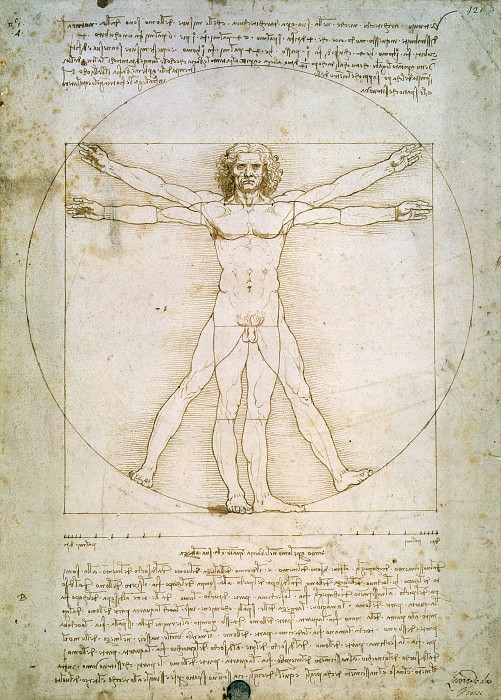Vitruvian Man Leonardo da Vinci (1452-1519)
Leonardo da Vinci – Vitruvian Man
Edit attribution
Download full size: 2835×3962 px (3,9 Mb)
Painter: Leonardo da Vinci
Location: Gallery of Accademia, Venice (Gallerie dell’Accademia).
The painting Vitruvian Man is a work that was created by Leonardo da Vinci in 1490-92 as an illustration for a book. The book itself was devoted to the writings of Vitruvius, and Da Vinci’s illustration was placed in her diary. The drawing clearly shows the figure of a man in two positions, one on top of the other in a different arrangement. In addition, the arms and legs are clearly seen branched out to the sides. It has been called the "canonical proportion" and is done with pen, ink, and watercolor, together with a metallic pencil, measuring 34.3 by 24.5 centimeters.
Description of Leonardo da Vinci’s Vitruvian Man
The painting Vitruvian Man is a work that was created by Leonardo da Vinci in 1490-92 as an illustration for a book. The book itself was devoted to the writings of Vitruvius, and Da Vinci’s illustration was placed in her diary.
The drawing clearly shows the figure of a man in two positions, one on top of the other in a different arrangement. In addition, the arms and legs are clearly seen branched out to the sides.
It has been called the "canonical proportion" and is done with pen, ink, and watercolor, together with a metallic pencil, measuring 34.3 by 24.5 centimeters. Today, this drawing is in the Venice Academy. The drawing also gained the status of a scientific work and a work of art.
It is worth noting that the main feature of Leonardo da Vinci’s drawing is the artist’s own interest in proportions. Rediscovering the mathematical proportions of the human body in the fifteenth century, Da Vinci and many other scientists made a major achievement, which was the forerunner of the Italian Renaissance.
When examining the drawing, one notices that the combined arrangement of the legs and arms gives two different arrangements. The pose where the arms are spread apart and the legs are brought together is clearly inscribed in a square. And from the other angle, the arrangement with the legs and arms open to both sides is in a circle.
If you look in more detail, you can see that as the center of the circle is the navel of the figure. A little later referring to this methodology, Corbusier was able to create his scale of proportions, the Modulor, which was able to influence the aesthetic component of architecture of the twentieth century. The drawing is most often used as an implicit symbol with the internal symmetry of the human body and the whole universe.
Кому понравилось
Пожалуйста, подождите
На эту операцию может потребоваться несколько секунд.
Информация появится в новом окне,
если открытие новых окон не запрещено в настройках вашего браузера.
You need to login
Для работы с коллекциями – пожалуйста, войдите в аккаунт (open in new window).

![Leonardo da Vinci - Madonna and Child [Workshop]](http://cdn.gallerix.asia/j/V/369985082/72456827.webp)

![Leonardo da Vinci - Portrait of a Young Lady [Follower]](http://cdn.gallerix.asia/j/V/369985082/1413258033.webp)
















COMMENTS: 7 Ответы
ОПЫТ О ЧЕЛОВЕКЕ
В метафизической цепочке
Звено, а не венец творенья.
Насколь милее одиночке-
Поэту ярое горенье
Уюта быта – столь же ангел
Значеньем превзойдёт царя.
Гривастый лев повыше рангом
Трудящегося муравья.
Креветки не имеют слуха,
А птиц не встретите в воде.
Но сокровенны сферы духа,
А мы живём в иной среде.
Мы, люди – всё-таки храним
Неяркий отсвет высшей дали.
Дойдёт до цели пилигрим,
А остальное всё детали.
что всё-таки означает эта фигура??
о перемещении руки и ноги
Это свидетельство того, что человеческое тело (человек) явление абсолютное, как и геометрические фигуры. Что красота не ошибка природа, а ее высшее проявление.
Гениальность Леонардо да Винчи проявляется в его картинах и чертежах. Один из любимых художников и лучших умов человечества.
Леонардо велик во всём и во все времена!
Названа так, потому-что Римский Архитектор Ветрувий обнаружил размерность человеческих форм, соотношений длины тела к длине вытянутых рук и т.д.
You cannot comment Why?
The image, Leonardo da Vincis Vitruvian Man, is a pen drawing on paper that depicts a male figure in two superimposed positions within a circle and a square. The figure is anatomically detailed and represents ideal human proportions.
What I see:
Subtexts: